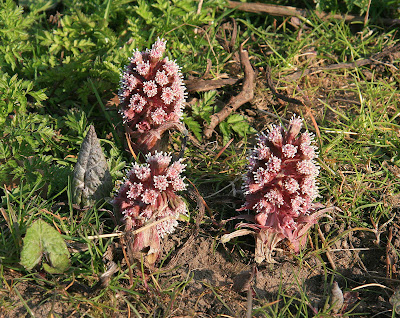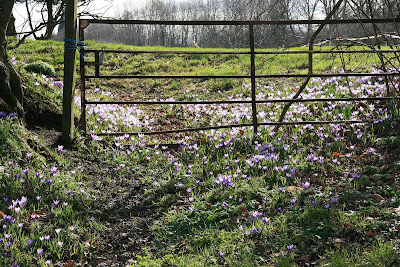
In my article on the Autumn Crocus (1) I related how, in the Middle Ages, the Knights of St. John of Jerusalem acquired land in the Southern Pennines. They grew the South Western European species Crocus nudiflorus as a source of saffron which they valued for its medicinal properties. Because I had not seen any evidence for the presence of the Knights of St. John in the Mersey Valley I have always assumed that our Crocus plants were washed down the Pennine watershed in winter floods, and I still think that that is the most likely origin of many of our colonies.
Nevertheless, an article which appeared in a natural history magazine several years ago added a new twist to the story. The article (2) was written by Steve Alton, a Nottinghamshire Conservation Officer. Mr Alton related how C. nudiflorus was once common in the flood meadows of the River Trent near the city of Nottingham but in that location it was usually accompanied by the Spring Crocus (Crocus vernus). It should be noted, of course, that the two species don’t actually flower together but in the spring C. vernus produces both flowers and leaves whilst in the case of C. nudiflorus only the distinctive leaves are visible at that time. In his article Mr Alton states that the Spring Crocus in the Nottingham area appeared to have spread out from Lenton Priory, which was owned not by the Knights of St. John but by monks of the Cluniac order. The priory was founded between 1108 and 1114 by William Peverel, son of William the Conqueror. This order originated in Cluny, in Burgundy (South Western France) where both the Spring and Autumn Crocuses grow wild. In addition it appears that the monks owned two hermitages – one in caves near the priory and the other across the Pennines at Kersall in Salford. This is almost certainly a reference to Kersall Cell in the Irwell Valley. Apparently there was a well-used road between the priory and Kersall and there are nine Autumn Crocus sites along its route.
After reading the article cited above it occurred to me to start looking for Spring Crocuses in the Mersey Valley and, in particular to look for sites where both species grow together.
Before I discuss my findings further I need to describe the Spring species in a bit more detail:
Crocus vernus is a central European species found from the Pyrenees to the Carpathians. It is a mountain plant found around snow patches and in mountain meadows and sub-alpine woods. It is taxonomically quite complex with many variants and at least two subspecies (3). Flowers colours range from purple through lilac to pure white; some plants are purple with white stripes. A major problem with looking for colonies which might be old is the fact that this species is still being planted as an ornamental and such planting could have occurred any time in the last century or so. Nevertheless, modern cultivars tend to be larger than the wild types and they are often planted with a yellow species (usually the hybrid Crocus x stellaris).
In Nottingham two of the areas where both Crocus species have lingered on are in churchyards and cemeteries, so I made a point of looking in Mersey Valley churchyards and cemeteries. My findings are as follows:
Heaton Mersey
There is a colony of Spring Crocuses in an overgrown site off Vale Road opposite an industrial estate. I’m not sure what the history of this site is except that there were bleach works in this area (hardly relevant, one would think, in this context). When I first found this site in the mid 1990s the plant colonies were clearly visible at the bases of some old gate posts but when Priscilla Tolfree and I visited it again a couple of years ago the plants were just holding their own against a sea of invading Ivy.
St. James Churchyard and Fletcher Moss Gardens, Didsbury
Apparently both the church and the churchyard have been much altered during the last few centuries (4) but there are a small handful of Spring Crocuses to be found in the upper part of the churchyard closest to the church. At the western end of the yard, furthest from the church, and at a lower elevation, there are some groups with the large cultivars and the yellow flowered hybrid, characteristic of modern plantings, referred to above.
On the lawn in front of the Old Parsonage nearby there is a large drift of Spring Crocuses of the ‘wild’ type – could these have been moved there during one of the periods when the churchyard was being altered? I suppose that this is possible but it must remain pure speculation.
Ford Lane and St. Wilfrid’s Churchyard, Northenden
Northenden is a ‘Crocus Hotspot’! The bank on the south side of Ford Lane (the opposite side from the river), near Didsbury Golf Course, is a good site for C. nudiflorus and slightly further on, around a gate leading on to the Golf Course, is a magnificent display of C. vernus (see top photograph above). These two populations do overlap slightly and are the best example that I know of the two species growing together in this area.
St. Wilfrid’s churchyard, in Northenden itself, has a huge population of C. vernus. I visited this churchyard most recently on Friday 6th March, 2009 and was greatly impressed by the magnificent and very beautiful drifts of this species. Equally impressive was the fact that, even this early in the spring, the flowers were being visited by a huge swarm of honey bees. Also present in the same churchyard was another species, C. tommasinianus (5). I suspect that some of the flowers that I saw were, in fact, hybrids between the two species. This is worrying because, in time, there is a chance that the C. vernus plants could be ‘hybridised-out’.
Southern Cemetery, Chorlton
This cemetery is rich in spring bulbs, particularly the north eastern boundary, adjacent to Nell Lane. There is little doubt that most of these have been planted fairly recently, by the local authorities, but there are drifts of C. vernus which I suspect may be older. There is certainly evidence that a substantial population of C. vernus was present in this area in the mid 19th century because the botanist Leo Grindon recorded such a population from “... a meadow opposite the gable of Hough End Hall” (6). I think that there is a very good chance that the Southern Cemetery plants are the remains of the same population. Again there is worrying evidence that these historic plants are being ‘hybridised-out’ by C. tommasinianus.
St. Michael’s Churchyard, Flixton
There is another population of C. vernus in this churchyard and Priscilla Tolfree found C. nudiflorus on the golf course nearby.
So, what are we to conclude? Frankly, it’s very difficult to know. The situation is like a giant jigsaw puzzle with many lost pieces. There may well have been (at least) two religious/monastic orders locally, who, between them, introduced two Crocus species into the Manchester area, almost certainly as a source of saffron. It will take a far, far better historian than me to sort it out! Nevertheless, I feel that these plants have great significance both in terms of local biodiversity and local history and heritage.
Dave Bishop, March 2009
References:
1. ‘The Autumn Crocus’ - FoCM Blog, Saturday 20th September, 2008
2. ‘Crocus Connections’ by Steve Alton, ‘Natural World’ No. 38, Autumn 1993
3. ‘The Genus Crocus’ by Brian Mathew, Batsford, 1982
4. ‘A History of Didsbury’ by Ivor R. Million, Didsbury Civic Society & E.J. Morten, 1969
5. ‘The Early Spring Crocus’ – FoCM Blog, Saturday 21st February, 2009
6. ‘The Manchester Flora’ by Leo H. Grindon, William White, 1859













